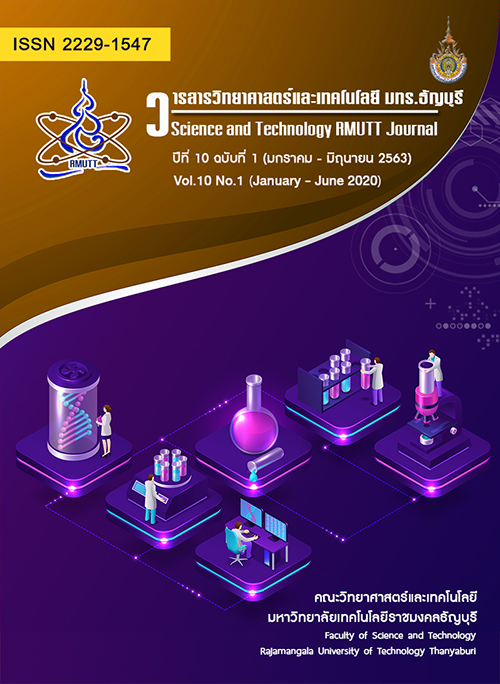Physical Chemical and Sensory Properties of Low Sugar Gummy
Main Article Content
Abstract
This research was aimed to evaluated effected of sucralose on physical chemical and sensory properties of low sugar gummy. The optimal formula of gummy consisted of water 200 ml sugar 200 g citric acid 4 g and gelatin 40 g. Sucralose were replaced at 25, 50, 75 and 100% of sugar. All of ingredient were boiled and stir until gentle then pour in to mold until cool. Chemical, physical and sensory (by 9-point hedonic scale test) qualities of the samples were determined. The best sensory test scores at 25 and 50% of sucralose. The color value (L, a*, b*) showed highest at 75% of sucralose (35.78, 3.38 and 10.08). In high sugar sample (25% sucralose) was lowest moisture content and water activity (19.10% and 0.79). The highest Gumminess Chewiness (0.71 and 6.55-6.59 kgf) were found in 75 and 100% of sucralose respectively.
Article Details
References
Marfil, P., Anhe, A. and Telis, V. Texture and microstructure of gelatin/corn starch based gummy confections. Food Biophysics. Vol 7, pp. 236-243. 2012.
Kanpairo Kamontip. Effect of Different Sweeteners on the Quality of Torch Ginger (Etlingeraelatior (Jack) R.M. Smith) Gummy Jelly. Science Burapha. Vol.23(2). May-August 2018.
Kleiner Leslie. Sugar Reduction in Confectionery and Related Applications. Journal of Nutritional Health & Food Engineering. Vol.4(2). 2016
Savitha Y.S., D. Indrani and Jamuna Prakashlk. Effect of replacement of sugar with sucralose and moltodextrin on rheological characteristics of wheat flour dough and quality of soft dough biscuits. Journal of Texture Studies. Vol. 39, pp.605–616.2008
Bannach G., Rafael R. Almeida, Luis. G. Lacerda, Egon Schnitzler, Massao Ionashiro. Thermal stability and thermal decomposition of sucralose. Ecletica quimica. Vol.34(4), PP. 21 – 26. 2009
Al-Dabbas, Maher M. and Al-Qudsi, Jamil M. Effect of partial replacement of sucrose with the artificial sweetener sucralose on the physico-chemical, sensory, microbial characteristics,and final cost saving of orange nectar. International Food Research Journal. Vol. 19(2), pp. 679-683. 2012
Vorgelegt von Mojgan Zandi aus Kerman. Studies on the Gelation of Gelatin Solutions and on the Use of Resulting Gels for Medical Scaffolds. PhD. Dissertation Universitaet Duisburg-Essen. 2008.
AOAC. (2000). Official Method of Analysis of AOAC International. 17th edition. USA.
Rattanpanon N. Food Chemistry. Faculty of Agro-Industry Chiangmai University.2000.
Laos, K. A., Kirs, E.B., Kikkas, A., C & Paalme, T.D. “Crystallization of the super saturated sucrose solutions in the presence of fructose, glucose and corn syrup. In European Congress of Chemical Engineering. (pp. 16-20).2007.
Jiamjariyatam R. Influence of gelatin and isomaltulose on gummy jelly properties. International food research Journal. Vol.25(2), pp. 776-783, April 2018.
Chanpho1 Kobporn, Supawadee Daodee1and Duangkamon Sakloetsakun1. “Effects of gelling and sweetening agents on characteristics of Maprang crude extract’s (Bouea macrophylla Griff) jelly product. The 7th Annual Northeast Pharmacy Research Conference of 2015 “Challenges and Opportunities of Pharmacy Profession in Post-Millennium Development Agenda” Faculty of Pharmaceutical Sciences, Khon Kaen University, Thailand. pp.290-295, March 2015
Mepanya Vilasinee. The complete study on the development of gummy jelly tamarind products. Phetchabun.: Rajabhat Phetchabun University, 2008.


